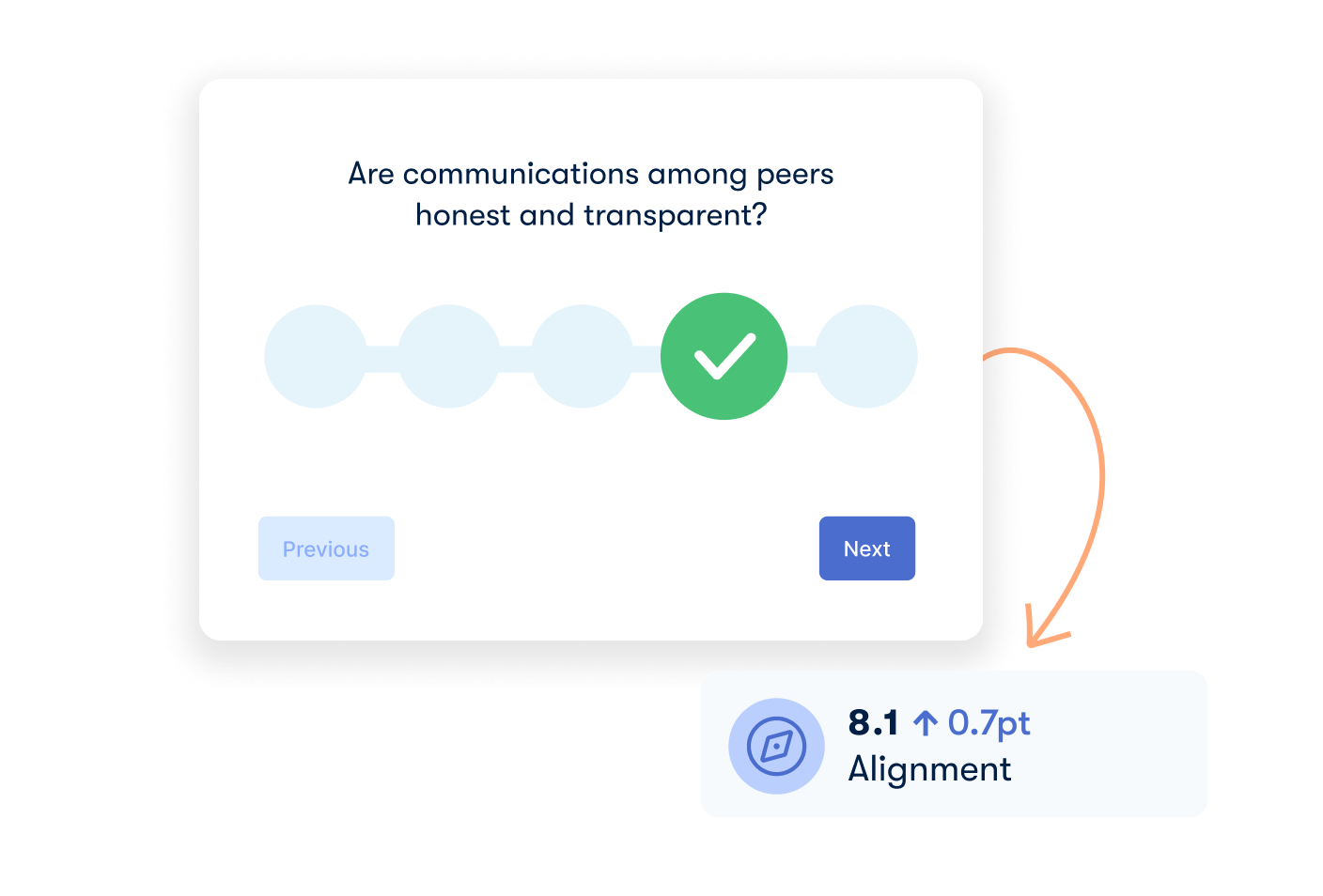There’s been a noticeable shift in recent years towards emphasizing employee satisfaction and mental health in the workplace instead of prioritizing the dollars and cents.
Long gone are the days where companies could skate by on simply offering employees a decent wage without empowering them or creating an inclusive workplace.
Nowadays, employers need to exceed expectations to retain talent. Not only does improving employee satisfaction increase engagement, boost productivity, and reduce costly turnover, it builds a healthy company culture.
Assess your organization’s employee experience in minutes

Find ways to improve employee satisfaction
What is employee satisfaction?
Employee satisfaction is related to the contentment level of your employees in their current positions.
Factors that influence employee satisfaction may include:
- Compensation
- Workload
- Scheduling flexibility
- Teamwork
- Available resources
- Perceptions of management
- Alignment with company culture
- Career opportunities
External factors can also influence employee satisfaction. For example, an employee who has to commute two hours might be less satisfied than one who is just a short drive away from the office, or one who works remotely. Some employees may be unsatisfied in their industry, while others may have personal issues affecting their day-to-day life at work.
How to improve employee satisfaction
1. Listen to employee feedback
More and more businesses are moving towards a positive feedback culture to boost employee engagement. A professional feedback culture values open and honest communication between employees, managers, and higher leadership, and encourages a steady flow of insight and advice.
A large part of feedback culture is seeking and acting upon employee comments and responses, enabling employees to give their insights on organizational and managerial decisions and concerns.
While transitioning to this type of corporate culture takes time and effort, the effects of employee satisfaction surveys and other forms of employee feedback offer numerous benefits, including higher overall employee satisfaction and retention.
Note that simply seeking feedback isn't enough to boost employee satisfaction — employees want to see their insights put into action. When employees feel empowered and believe they directly contribute to business operations, they are more likely to provide honest input, leading to a positive feedback loop and improving employee satisfaction.

2. Stop micromanaging
Micromanagement is a productivity killer that can negatively affect employee morale and performance. It can also stifle creativity and discourage initiative.
Placing too much emphasis on the minutiae of daily operations can cause you to miss the bigger picture, and unfortunately can result in an increased risk of burnout for the manager.
While there is a time and a place for more direct involvement in an employee’s tasks (i.e., during the onboarding period), micromanagement tends to be less time efficient and cause more stress to those involved.
Not sure if you might be micromanaging your team? Check out our free template to assess your management style.
3. Recognize and reward performance
Employees want to feel valued and appreciated by their managers. They also want to feel that the work they do is both personally fulfilling and contributes to the growth of the company.
When you recognize employees and reward stand-out effort, your team will feel more confident in their work and will be more likely to push themselves to perform well or share ideas in the future.While recognition is important, the type of reward you give employees is also significant. Some people may feel uncomfortable with company-wide recognition and prefer smaller, more private acknowledgement. This recognition can come in the form of positive performance feedback and reinforcement or thoughtful perks like time off or discounted services.
4. Promote a healthy lifestyle
Health issues and work-related stress are among the most significant causes of workplace absenteeism. An office culture that supports a healthy lifestyle and programs that encourage employee well-being can help prevent burnout, fatigue, and other illnesses.
Along with health benefits, you can promote your employees' physical and mental well-being in several ways, including:
- Fitness classes
- Access to health food services
- Ergonomic office equipment
- Flexible work schedules
5. Maintain a comfortable work environment
Even seemingly minor things can have an enormous impact on employee satisfaction and experience. Lagging servers and computers, for example, can be a constant source of frustration and slow down productivity, while inadequate facilities make employees uncomfortable and feel undervalued.
Many studies have shown that the workplace environment can dramatically affect employee satisfaction. In addition to factors like lighting and temperature, even small decisions like allowing employees to leave personal items at their workstations can improve employee experience.

6. Improve communication and transparency
Nobody likes to be kept in the dark about decisions and changes in the workplace. Rumours about job security, significant workplace changes, and even shifts in corporate culture can seriously impact employee job satisfaction and morale.
A transparent culture can start with the use of internal communication tools to provide updates on current jobs, growth opportunities, and significant changes. Even better is seeking employee input about any potential changes, but the simple act of communicating helps employees feel respected and more engaged with the company.
7. Support employee development
One of the key reasons employees leave their current jobs is stagnation and lack of career growth. Managers can encourage career development with training, workshops, and expanding the scope of their roles.
An excellent way to start conversations about professional development is to ask employees what they want from their work and where they see themselves in the future. Managers should have open discussions about growth opportunities in the company and help employees set short and long term goals to move up in the company.
Training also has the added benefit of boosting productivity and improving performance by empowering employees to put their new skills to the test.
8. Develop a social culture
The new reality of remote work has left many employees feeling isolated and disconnected from their peers. Encouraging healthy work relationships between co-workers can result in stronger team bonds and lessen the risk of disengagement.
Social connections in the office can foster a more positive work environment and boost job satisfaction. Employees may feel more confident about sharing their ideas and providing feedback, while friendly teams are more likely to seek collaborative solutions in challenging situations.

9. Live the company mission
Most people want to work for a company with a strong vision and mission. Employees whose personal values align with the company's mission are more likely to be satisfied with their jobs as they know their work has meaning and contributes to the greater good.
10. Reduce ineffective operations
Ineffective or inefficient operations can be a considerable roadblock to keeping employees motivated. Job satisfaction might drop when an employee spends more time navigating processes and dealing with red tape than on productive, meaningful work.
Wasted time can result in an employee worrying about their deadlines. They may even disengage from their work completely. Managers can improve employee well-being and productivity by streamlining operations, removing hurdles, and allowing employees to focus on their work.
11. Give employees more control over their roles
While managers often understand their employees' strengths and where they can improve, letting employees shape their own roles can often produce better results. Employees who can tailor their tasks to their strengths are more likely to excel at that role and will often be more proactive and produce high-quality work.Giving employees more control doesn't mean that management cedes control entirely. Managers can use feedback sessions or performance reviews to evaluate an employee's role and function and ensure that it still aligns with the greater needs of the business.
Why employee satisfaction matters
Losing an employee can be more expensive than you'd think. Some studies estimate that losing an employee will cost an organization 1.5 times the employee's salary. In addition to losing productivity, the company will have to train a new hire and adapt to their learning curve.
Satisfied employees are less likely to leave their jobs, which can dramatically reduce unnecessary turnover and its associated costs. Happier employees are also more productive and deliver higher-quality work than their dissatisfied counterparts.
An enjoyable workplace fosters higher productivity and reduces turnover, dramatically influencing a business's bottom line. Many of the interventions necessary to cultivate happy employees are affordable and can happen at a management level.
As human resources departments and managers start to understand the importance of employee satisfaction, it may be the time to begin implementing measures to enhance your team’s employee experience.
Employee engagement vs. job satisfaction
Some people use the terms ‘employee satisfaction’ and ‘employee engagement’ interchangeably, but the two are vastly different concepts. Satisfaction provides clues as to how happy an employee is in their current position or if they are likely to seek out other opportunities.
On the other hand, employee engagement refers to how actively passionate an employee is about their work. Engaged employees are more likely to deliver high-quality work and will be motivated to go above and beyond with their tasks.
Employee satisfaction and engagement are valuable metrics, and ideally, managers should make efforts to create a positive work environment that encourages both. Satisfied employees are more likely to become engaged employees, so promoting employee satisfaction levels will inevitably lead to higher productivity.
Measuring employee satisfaction
Employee satisfaction is a key factor in reducing turnover and encouraging employee retention and engagement, but managers may find it challenging to measure employee satisfaction based on observation alone. It’s essential to put in a concerted effort using measurement tools to capture the employee experience, identify potential areas of improvement, and boost employee satisfaction.
Employee Surveys
An employee satisfaction survey is the cornerstone of measuring employee well-being. If you use them correctly, surveys are an excellent tool. They provide an easy and anonymous way for employees to provide valuable and honest feedback.
The main challenge with any employee satisfaction survey is developing the right questions. Employees may not provide honest answers due to fear of reprisal, or they may not want to answer the survey at all. Asking the right questions can be more revealing and yield more insightful answers. Some common best practices for survey questions include:
- Avoid questions with simple "yes-no" answers, such as, "Do you like working here?"
- Avoid leading questions like, "Don't you absolutely love the new buffet lunch option?"
- Ask open-ended questions that give measurable, valuable answers, such as, "What can we do to improve the office environment?"
How often you send out the survey can also affect how many people answer it. Too many surveys, and employees will start ignoring them, while too few will feel superficial and insincere.
Short engagement surveys are an excellent option for quickly measuring the current employee mood and can be sent out more frequently. You can send out Pulse Surveys weekly or fortnightly and use a dedicated Pulse Survey tool to keep track of overall employee trends.

Longer surveys are great for discovering potential issues affecting employee morale. Standard intervals for longer surveys include monthly, quarterly, and semi-annually.
Another way to raise survey participation rates is to highlight the fact that surveys are anonymous. Anonymous surveys will often produce more genuine feedback, especially when you pair them with well-designed questions.
Group sessions and one-on-one meetings
While surveys are an excellent way to measure employee satisfaction and get an overview of the current situation, both group and individual meetings let you dig deeper and get more comprehensive answers. For these sessions to be effective, the company must foster a culture of open communication, where employees know that management hears and acknowledges their voices.
Both group and individual feedback meetings have challenges that you as a manager need to overcome.
Shy or socially anxious employees may be reluctant to speak up in front of an audience, or you may find that one or two individuals dominate the meeting by airing their grievances. However, group feedback meetings can provide an ideal space for brainstorming solutions and increasing employee satisfaction if properly managed.
Similarly, for one-on-one meetings, you need to nurture and trusting relationship when seeking input on employee satisfaction. However, these meetings do provide the best opportunity to identify barriers to employee satisfaction, with both manager and employee going in-depth about issues, concerns, and potential solutions.
Equip HR and managers with tools to engage, recognize, and drive performance.




